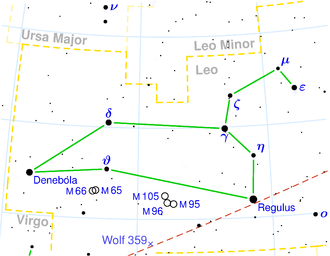NGC 3768
| Galaxy NGC 3768 |
|
|---|---|

|
|
| SDSS recording | |
| AladinLite | |
| Constellation | lion |
|
Position equinox : J2000.0 , epoch : J2000.0 |
|
| Right ascension | 11 h 37 m 14.5 s |
| declination | + 17 ° 50 ′ 24 ″ |
| Appearance | |
| Morphological type | S0 |
| Brightness (visual) | 12.5 mag |
| Brightness (B-band) | 13.5 likes |
| Angular expansion | 1.6 ′ × 0.9 ′ |
| Position angle | 155 ° |
| Surface brightness | 12.8 mag / arcmin² |
| Physical data | |
| Affiliation | LGG 246 |
| Redshift | 0.011585 +/- 0.000063 |
| Radial velocity | 3473 +/- 19 km / s |
|
Stroke distance v rad / H 0 |
(153 ± 11) · 10 6 ly (46.8 ± 3.3) Mpc |
| history | |
| discovery | William Herschel |
| Discovery date | March 14, 1784 |
| Catalog names | |
| NGC 3768 • UGC 6589 • PGC 35968 • CGCG 097-030 • MCG + 03-30-024 • 2MASX J11371444 + 1750241 • GC 2469 • H III 29 • h 923 • LDCE 831 NED002 | |
NGC 3768 is a lenticular galaxy of the Hubble type S0 in the constellation Leo, north of the ecliptic . It is estimated to be 153 million light years away from the Milky Way and has a diameter of about 75,000 ly.
In the same area of the sky are the galaxies NGC 3764 , NGC 3790 , NGC 3801 , NGC 3803 , among others .
The object was discovered by Wilhelm Herschel on March 14, 1784 .
